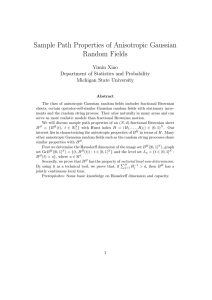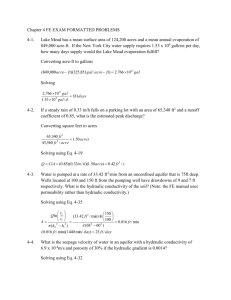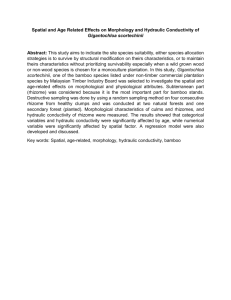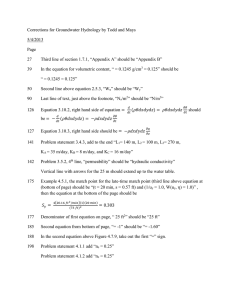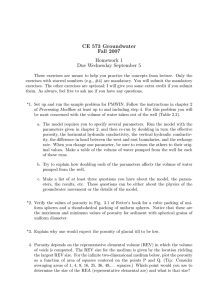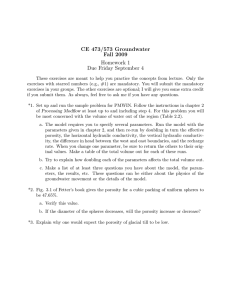Random field models for hydraulic conductivity in ground water flow
advertisement
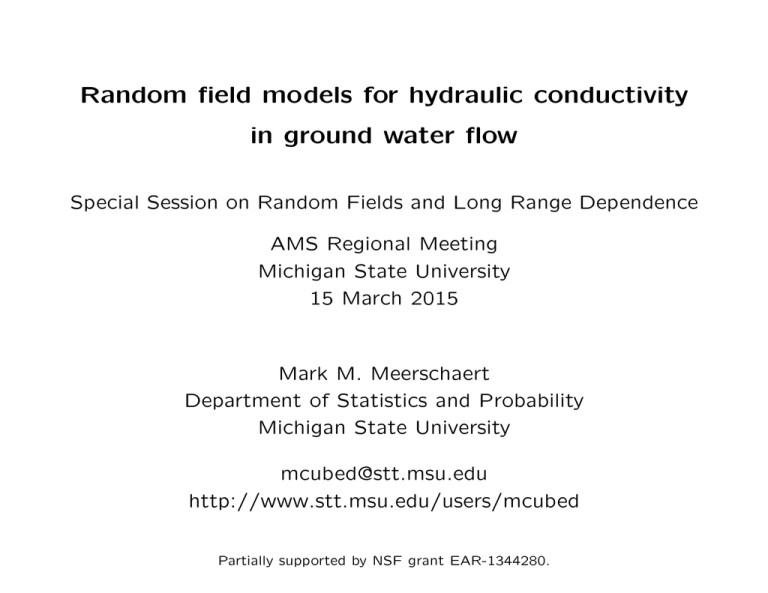
Random field models for hydraulic conductivity in ground water flow Special Session on Random Fields and Long Range Dependence AMS Regional Meeting Michigan State University 15 March 2015 Mark M. Meerschaert Department of Statistics and Probability Michigan State University mcubed@stt.msu.edu http://www.stt.msu.edu/users/mcubed Partially supported by NSF grant EAR-1344280. Abstract A standard model in ground water hydrology uses random fields to interpolate sparse data on hydraulic conductivity. The resulting random field is used to parameterize a partial differential equation model for flow and transport, which is then solved by numerical methods. This talk will review the state of the art in such models, and discuss open problems. Acknowledgments Boris Baeumer, Maths & Stats, U Otago, Dunedin, New Zealand David A. Benson, Geology & Geo Eng, Colorado School of Mines Hermine Biermé, MAP5 Université René Descartes, Paris Geoffrey Bohling, Kansas Geological Survey, Lawrence, Kansas Mine Dogan, Geology and Geophysics, University of Wyoming David Hyndman, Geological Sciences, Michigan State University Tomasz J. Kozubowski, Math and Stat, Univ. of Nevada, Reno Chae Young Lim, Statistics and Probability, Michigan State U Silong Lu, Tetra Tech, Inc., Atlanta, GA Fred J. Molz, Environmental Eng & Science, Clemson University Farzad Sabzikar, Statistics and Probability, Michigan State U Hans-Peter Scheffler, Mathematics, Uni Siegen, Germany Remke Van Dam, Institute for Future Environments, QUT Equations for groundwater flow and transport Step 1: Measure hydraulic conductivity K (x), a tensor field that codes how easily water can flow through a porous medium. Step 2: Compute the hydraulic head (pressure) h(x, t) by numerically solving the groundwater flow equation ∂h(x, t) = a∇ · K (x)∇h(x, t) + f (x, t), ∂t where f (x, t) is a source/sink term. Step 3: Compute the velocity field v (x, t) using Darcy’s Law v (x, t) = −bK (x)∇h(x, t). Groundwater flow and transport (continued) Step 4: Compute solute concentration C(x, t) by numerically solving the advection-dispersion equation ∂C(x, t) = −∇ · v (x, t)C(x, t) + ∇ · D (x, t)∇C(x, t) + F (x, t), ∂t where F (x, t) is a source/sink term and D (x, t) is the dispersivity tensor (normal covariance matrix). Typical simplifying assumptions: 1. Steady state hydraulic head h(x) 2. Steady state velocity field v (x) 3. Scalar dispersion D (x) = λkv (x)kI 4. Scalar hydraulic conductivity K (x) = K(x)I 5. Gaussian ln K field with isotropic exponential correlation Data requirements Consider a bounded (rectangular) domain in R2 or R3 Establish (or assume) boundary conditions for hydraulic head h Measure hydraulic conductivity K at some points (expensive!) Extrapolate K field to all (> 106) grid points in the domain Typically, we have just a few vertical columns of K data Each vertical column contains 100 to 500 data points Data source: The MADE site MAcroDispersion Experimental Site (MADE) in Columbus MS. 300 LEGEND MADE−2 test boundary MADE−3 source trench N 2D GPR lines 3D GPR cubes HRK profiles 200 northing [m] ICA cube 100 121108A 111108C MLS cube 111108B 111108A 0 0 100 easting [m] 200 Hydraulic conductivity data distribution probability density Histogram of measured ln K data (one column, n = 561). 0.6 (a) 0.4 0.2 0 −6 −4 −2 0 ln (K [m/day]) 2 Hydraulic conductivity data correlation Autocorrelation function for one column of ln K data (n = 561). ACF 1 (a) 0.5 0 d= 0 0 0.2 0.4 0.6 distance [m] 0.8 1 Fractional difference (fractal filter) Apply a fractional difference filter to the data Xn = ln K(x, y, zn) to obtain an uncorrelated sequence Zn = ∞ X j=0 (−1)j ! d Xn−j j where the fractional binomial coefficients ! Γ(d + 1) d = j j!Γ(j − d + 1) for some d > 0. Then Xn is a fractionally integrated white noise. If d = 1 then Zn = Xn − Xn−1, so that Xn = Z1 + · · · + Zn. If Zn is Gaussian and 0.5 < d < 1.5, then Xn is an fBm with Hurst index H = d − 0.5 sampled at equally spaced points. Filtering out the data correlation A fractional difference with d = 0.9 removes the correlation. ACF 1 (b) 0.5 0 d= 0.9 0 0.2 0.4 0.6 distance [m] 0.8 1 Distribution of the filtered data probability density A fractional difference with d = 0.9 reveals that the underlying distribution has heavier tails and a sharper peak than the best fitting Gaussian. 3 (b) 2 1 0 −1.5 −1 −0.5 0 0.5 fractionally differenced ln K 1 1.5 Our model for ln K We simulate an anisotropic Gaussian ln K field in each layer, conditional on the observed data (solid black lines) and sample one column (white dotted line) for model validation. Simulated column of ln K data probability density The simulated ln K data in a single column (white dotted line) is a Gaussian mixture, resembling the ln K data. 3 (d) 2 1 0 −1.5 −1 −0.5 0 0.5 fractionally differenced ln K 1 1.5 Operator scaling random field model We simulate an anisotropic Gaussian random field Xψ (x) = Re Z eix·k − 1 ψ(k)−H−q/2 B(dk). d X Rd with 0 < H < 1, q = a1 + · · · + ad, ϕ(k) = j=1 1/2 Dj |k · θj |2/aj and B(dk) is independently scattered complex-valued Gaussian. Then each xi 7→ Xψ (x1, . . . , xd) is an fBm with Hi = H/ai. d Operator scaling: Xψ (cE x) = cH Xψ (x) where E = diag(a1, . . . , ad). Here cE = exp(E ln c) where exp(A) = I + A + A2/2! + · · · Fitting to the K data Ground penetrating radar identifies the layer boundaries. Simulate ln K field with H = 0.4, θ1 = (1, 0)′, θ2 = (0, 1)′, D1 = 10, D2 = 1, a1 = a2 = 1 (mild anisotropy). Adjust ln K field in each layer to observed mean and variance. Condition on the observed ln K data by random bridging: Apply kriging to the data and the realization, then subtract. The resulting correlation in the x direction is consistent with the data (4 m spacing), insufficient to judge H1 6= H2. Simulation method (spectral synthesis) Define X̄ψ (xℓ) = X eixℓ·kj ψ(kj )−H−q/2 B(∆kj ). j where the kj are evenly spaced grid points in the small subrectangles ∆kj of a large annular rectangle in Rd. Simulate B(∆kj ), iid as Z1 + iZ2, Z1, Z2 ∼ N (0, σ 2|∆kj |/2). Then X̄ψ (xℓ) is the discrete FT of ψ(kj )−H−q/2 B(∆kj ). h i Use FFT to compute, then Xψ (xℓ) ≈ Re X̄ψ (xℓ) − X̄ψ (0) . In dimension d = 1 this is the spectral synthesis method. Parameter estimation Given spatial data wℓ on a regular grid of points xℓ ∈ Rd Assume wℓ = X̄ψ (xℓ) = P ixℓ·kj ψ(k )−H−q/2 B(∆k ) j j je Invert the discrete FT to get yj = ψ(kj )−H−q/2 B(∆kj ) Solve the nonlinear regression log |yj | = log |ψ(kj )−H−q/2|+log |εj | Here εj = B(∆kj ) are iid N (0, σ 2|∆kj |) Note E(log |εj |) → −∞ as ∆k → 0. Consistent, asymptotically normal estimates of H1, H2, θ1, θ2, D1, D2. Open question We can also define the anisotropic random field X ϕ (x ) = Z y ∈Rd h i H−q/2 H−q/2 ϕ(x − y ) − ϕ(0 − y ) B(dy ) where B(dy ) is an independently scattered Gaussian random measure, and ϕ(cE x) = c ϕ(x) is an operator scaling filter. Idea: ψ(k) is the FT of ϕ(x), B(dk) is the FT of B(dy ). Again xi 7→ Xϕ(x1, . . . , xd) is an fBm with Hi = H/ai. d Again Xϕ(cE x) = cH Xϕ(x) where E = diag(a1, . . . , ad). Are these two processes the same? [Yes when d = 1 or isotropic.] Problem: Explicit computation of the covariance function? Open problems • Infinitely divisible noise B(dk) • tempered power law (Matérn) filters in Rd • Simulation methods with conditioning • Sample path properties [Xiao] • Operator scaling vector fields [Didier et al.] References 1. D.A. Benson, M.M. Meerschaert, B. Baeumer, H.P. Scheffler, Aquifer Operator-Scaling and the Effect on Solute Mixing and Dispersion, Water Resources Research, Vol. 42 (2006), No. 1, W01415 (18 pp.), doi:10.1029/2004WR003755. 2. H. Biermé, M.M. Meerschaert, H.P. Scheffler, Operator Scaling Stable Random Fields, Stochastic Processes and their Applications, Vol. 117 (2007), pp. 312–332. 3. G. Didier and V. Pipiras, Integral representations and properties of operator fractional Brownian motions, Bernoulli, 17(1), pp. 1–33 (2011). 4. Mine Dogan, Remke L. Van Dam, Gaisheng Liu, Mark M. Meerschaert, James J. Butler Jr., Geoffrey C. Bohling, David A. Benson, and David W. Hyndman, Predicting flow and transport in highly heterogeneous alluvial aquifers, Geophysical Research Letters, Volume 41 (2014), Issue 21, pp. 7560–7565, 10.1002/2014GL061800. 5. H. Guo, C.Y. Lim, M.M. Meerschaert, Local Whittle estimator for anisotropic random fields, Journal of Multivariate Analysis, Vol. 100 (2009), No. 5, pp. 993-1028, doi:10.1016/j.jmva.2008.10.002. 6. M.G. Herrick, D.A. Benson, M.M. Meerschaert and K.R. McCall, Hydraulic conductivity, velocity, and the order of the fractional dispersion derivative in a highly heterogeneous system, Water Resources Research, Vol. 38 (2002), No. 11, pp. 1227-1239, article 10.1029/2001WR000914. 7. Bill X. Hu, Mark M. Meerschaert, Warren Barrash, David W. Hyndman, Changming He, Xinya Li, and Luanjing Guo, Examining the Influence of Heterogeneous Porosity Fields on Conservative Solute Transport, Journal of Contaminant Hydrology, Vol. 108 (2009), Issues 3-4, pp. 77–88, doi:10.1016/j.jconhyd.2009.06.001. 8. M. Kohlbecker, S.W. Wheatcraft and M.M. Meerschaert, Heavy tailed log hydraulic conductivity distributions imply heavy tailed log velocity distributions, Water Resources Research, Vol. 42 (2006), No. 4, article W04411 (12 pp.), doi:10.1029/2004WR003815. 9. C.Y. Lim, M.M. Meerschaert, and H.-P. Scheffler, Parameter estimation for operator scaling random fields, Journal of Multivariate Analysis, Vol. 123 (2014), pp. 172–183, DOI: 10.1016/j.jmva.2013.09.010. 10. 118.M.M. Meerschaert, T.J. Kozubowski, F.J. Molz, and S. Lu, Fractional Laplace Model for Hydraulic Conductivity Geophysical Research Letters, Vol. 31, No. 8 (2004), pp. 1–4, doi:10.1029/2003GL019320. 11. M.M. Meerschaert, M. Dogan, R.L. Van Dam, D.W. Hyndman, and D.A. Benson, Hydraulic Conductivity Fields: Gaussian or Not? Water Resources Research, Vol. 49 (2013), pp. 4730–4737, doi:10.1002/wrcr.20376 12. M.M. Meerschaert and Farzad Sabzikar, Tempered Fractional Brownian Motion, Statistics and Probability Letters, Vol. 83 (2013), No. 10, pp. 2269–2275. 13. M.M. Meerschaert, W. Wang, and Y. Xiao, Fernique-type inequalities and moduli of continuity for anisotropic Gaussian random fields, Transactions of the American Mathematical Society, Vol. 365 (2013), No. 2, pp. 1081–1107. 14. N.D. Monnig, D.A. Benson, M.M. Meerschaert, Ensemble Solute Transport in 2-D Operator-Scaling Random Fields, Water Resources Research, Vol. 44 (2008), W02434, doi:10.1029/2007WR005998. 15. Y. Xiao, Sample path properties of anisotropic Gaussian random fields. In: A Minicourse on Stochastic Partial Differential Equations, (D. Khoshnevisan and F. Rassoul-Agha, editors), Lecture Notes in Math. 1962, pp. 145–212, Springer, New York , 2009.
